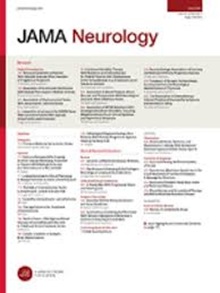GLP-1RA and SGLT2i Medications for Type 2 Diabetes and Alzheimer Disease and Related Dementias
IF 20.4
1区 医学
Q1 CLINICAL NEUROLOGY
引用次数: 0
Abstract
ImportanceThe association between glucagon-like peptide-1 receptor agonists (GLP-1RAs) and sodium-glucose cotransporter-2 inhibitors (SGLT2is) and risk of Alzheimer disease and related dementias (ADRD) remains to be confirmed.ObjectiveTo assess the risk of ADRD associated with GLP-1RAs and SGLT2is in people with type 2 diabetes (T2D).Design, Setting, and ParticipantsThis target trial emulation study used electronic health record data from OneFlorida+ Clinical Research Consortium from January 2014 to June 2023. Patients were 50 years or older with T2D and no prior diagnosis of ADRD or antidementia treatment. Among the 396 963 eligible patients with T2D, 33 858 were included in the GLP-1RA vs other glucose-lowering drug (GLD) cohort, 34 185 in the SGLT2i vs other GLD cohort, and 24 117 in the GLP-1RA vs SGLT2i cohort.ExposuresInitiation of treatment with a GLP-1RA, SGLT2i, or other second-line GLD.Main Outcomes and MeasuresADRD was identified using clinical diagnosis codes. Hazard ratios (HRs) with 95% CIs were estimated using Cox proportional hazard regression models with inverse probability of treatment weighting (IPTW) to adjust for potential confounders.ResultsThis study included 33 858 patients in the GLP-1RA vs other GLD cohort (mean age, 65 years; 53.1% female), 34 185 patients in the SGLT2i vs other GLD cohort (mean age, 65.8 years; 49.3% female), and 24 117 patients in the GLP-1RA vs SGLT2i cohort (mean age, 63.8 years; 51.7% female). In IPTW-weighted cohorts, the incidence rate of ADRD was lower in GLP-1RA initiators compared with other GLD initiators (rate difference [RD], −2.26 per 1000 person-years [95% CI, −2.88 to −1.64]), yielding an HR of 0.67 (95% CI, 0.47-0.96). SGLT2i initiators had a lower incidence than other GLD initiators (RD, −3.05 per 1000 person-years [95% CI, −3.68 to −2.42]), yielding an HR of 0.57 (95% CI, 0.43-0.75). There was no difference between GLP-1RAs and SGLT2is, with an RD of −0.09 per 1000 person-years (95% CI, −0.80 to 0.63) and an HR of 0.97 (95% CI, 0.72-1.32).Conclusion and RelevanceIn people with T2D, both GLP-1RAs and SGLT2is were statistically significantly associated with decreased risk of ADRD compared with other GLDs, and no difference was observed between both drugs.GLP-1RA和SGLT2i药物治疗2型糖尿病和阿尔茨海默病及相关痴呆
胰高血糖素样肽-1受体激动剂(GLP-1RAs)和钠-葡萄糖共转运蛋白-2抑制剂(SGLT2is)与阿尔茨海默病和相关痴呆(ADRD)风险之间的关系仍有待证实。目的评估2型糖尿病(T2D)患者GLP-1RAs和SGLT2is相关的ADRD风险。设计、设置和参与者本目标试验模拟研究使用了OneFlorida+临床研究联盟2014年1月至2023年6月的电子健康记录数据。患者年龄≥50岁,患有T2D,既往无ADRD诊断或抗痴呆治疗。在396 963例符合条件的t2dm患者中,33 858例被纳入GLP-1RA与其他降糖药物(GLD)组,34 185例被纳入SGLT2i与其他GLD组,24 117例被纳入GLP-1RA与SGLT2i组。开始GLP-1RA、SGLT2i或其他二线GLD治疗。主要结局和措施使用临床诊断代码确定adrd。使用Cox比例风险回归模型估计95% ci的风险比(hr),该模型具有处理加权逆概率(IPTW),以调整潜在混杂因素。结果本研究纳入GLP-1RA与其他GLD队列的33858例患者(平均年龄65岁;53.1%女性),SGLT2i与其他GLD队列的34185例患者(平均年龄65.8岁;49.3%女性)和24117例GLP-1RA vs SGLT2i队列患者(平均年龄63.8岁;51.7%的女性)。在iptw加权队列中,与其他GLD启动者相比,GLP-1RA启动者的ADRD发生率较低(率差[RD], - 2.26 / 1000人-年[95% CI, - 2.88至- 1.64]),HR为0.67 (95% CI, 0.47-0.96)。SGLT2i启动者的发病率低于其他GLD启动者(RD, - 3.05 / 1000人-年[95% CI, - 3.68至- 2.42]),风险比为0.57 (95% CI, 0.43-0.75)。GLP-1RAs和SGLT2is之间没有差异,RD为- 0.09 / 1000人年(95% CI, - 0.80 - 0.63), HR为0.97 (95% CI, 0.72-1.32)。结论及相关性在T2D患者中,GLP-1RAs和SGLT2is与其他GLDs相比,与降低ADRD风险有统计学意义,两种药物之间无差异。
本文章由计算机程序翻译,如有差异,请以英文原文为准。
求助全文
约1分钟内获得全文
求助全文
来源期刊

JAMA neurology
CLINICAL NEUROLOGY-
CiteScore
41.90
自引率
1.70%
发文量
250
期刊介绍:
JAMA Neurology is an international peer-reviewed journal for physicians caring for people with neurologic disorders and those interested in the structure and function of the normal and diseased nervous system. The Archives of Neurology & Psychiatry began publication in 1919 and, in 1959, became 2 separate journals: Archives of Neurology and Archives of General Psychiatry. In 2013, their names changed to JAMA Neurology and JAMA Psychiatry, respectively. JAMA Neurology is a member of the JAMA Network, a consortium of peer-reviewed, general medical and specialty publications.
 求助内容:
求助内容: 应助结果提醒方式:
应助结果提醒方式:


